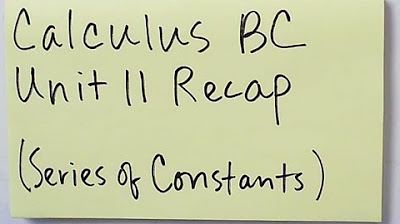Comparison Tests | MIT 18.01SC Single Variable Calculus, Fall 2010
TLDRThis video script provides a detailed exploration of three infinite series and their convergence properties. The first series, involving a ratio of linear and cubic terms, is analyzed using the limit comparison test, revealing its convergence. The second, a geometric series with a common ratio greater than one, is identified as divergent. The third series, involving the natural logarithm, is more complex and requires a creative approach to show its convergence by bounding it with a known convergent series. The script offers a comprehensive guide to understanding convergence tests for infinite series.
Takeaways
- 📚 In class, you've been learning about convergence tests for infinite series.
- ➗ The first series is the sum from n equals 0 to infinity of (5n + 2) / (n^3 + 1).
- 📝 The second series is the sum from n equals 1 to infinity of (1 + √5 / 2)^n.
- 📈 The third series is the sum from n equals 1 to infinity of ln(n) / n^2.
- 🔍 For the first series, use the limit comparison test with 5 / n^2 to determine convergence.
- ✅ The first series converges because it behaves like 1 / n^2, which is a convergent series.
- 🚫 The second series diverges because it is a geometric series with a common ratio greater than 1.
- 💡 For the third series, compare ln(n) / n^2 to 1 / n^(3/2) using a modified comparison test.
- ✔️ The third series converges because ln(n) / n^(3/2) is smaller than 1 / n^(3/2), which converges.
- 🔗 Use the comparison test to determine if a series converges by comparing it to a known convergent or divergent series.
Q & A
What are the three series discussed in the video?
-The three series discussed are: 1) the sum from n=0 to infinity of (5n + 2) / (n^3 + 1), 2) the sum from n=1 to infinity of (1 + √5/2)^n, and 3) the sum from n=1 to infinity of ln(n) / n^2.
What is the purpose of analyzing these series?
-The purpose is to determine whether each of these series converges or diverges.
What is the first test suggested for the first series?
-The first test suggested for the first series is the comparison test.
How does the comparison test work for the first series?
-The comparison test for the first series involves comparing the magnitude of the top and bottom of the ratio, and then comparing it to a known series (1/n^2) that converges.
What is the result of applying the limit comparison test to the first series?
-The limit comparison test shows that the first series converges because the limit of the ratio of the series to a known convergent series (5/n^2) is 1.
Why is the second series a geometric series?
-The second series is a geometric series because it has a constant ratio of (1 + √5/2) raised to the power of n.
What condition must the common ratio of a geometric series meet to converge?
-The common ratio of a geometric series must be between -1 and 1 (exclusive) for the series to converge.
Why does the second series diverge?
-The second series diverges because the common ratio (1 + √5/2) is greater than 1.
What is the approach for analyzing the third series?
-The approach for the third series involves using a comparison test with a clever manipulation of the logarithmic term to show that it is bounded above by a convergent series.
How does the logarithmic term ln(n) compare to n^p as n approaches infinity for any positive p?
-The limit of ln(n)/n^p as n approaches infinity is 0 for any positive p, meaning ln(n) grows much slower than any power of n.
What conclusion is reached for the third series?
-The third series converges because it is bounded above by a series that is known to converge (1/n^(3/2)).
What is the significance of the limit comparison test in analyzing series?
-The limit comparison test is significant as it allows for a direct comparison between the behavior of two series, helping to determine convergence by comparing them to known convergent or divergent series.
Outlines
📚 Introduction to Convergence Tests for Infinite Series
The video script begins with an introduction to convergence tests for infinite series, which are mathematical tools used to determine whether a series will have a finite sum or diverge to infinity. The instructor presents three series examples for the viewers to analyze and decide on their convergence or divergence. The series are: (1) a ratio of a linear term to a cubic term, (2) a geometric series with a specific constant ratio, and (3) a series involving the natural logarithm of n over n squared. The audience is encouraged to pause the video and attempt the problem before continuing to watch the analysis.
🔍 Analyzing Series Convergence Using Limit Comparison Test
This paragraph delves into the analysis of the first series using the limit comparison test. The series is simplified by focusing on the leading terms of the numerator and denominator, which are of the order of n and n cubed, respectively. The instructor explains that the series behaves similarly to 1 over n squared, which is known to converge. The limit comparison test is then applied by comparing the series to a simpler one, 5 over n squared, which is a scaled version of the convergent 1 over n squared series. The conclusion is that since the compared series converges, the original series also converges.
📉 Divergence of a Geometric Series with a Common Ratio Greater Than 1
The second series is identified as a geometric series with a common ratio of 1 plus the square root of 5 over 2. The instructor explains that geometric series converge if the absolute value of the common ratio is between -1 and 1. By demonstrating that the common ratio is greater than 1, it is established that the series diverges because the terms of the series increase without bound. The conclusion is that part B of the series does not converge due to the growing terms.
📈 Convergence of a Series Involving Logarithmic and Power Terms
The final paragraph discusses the convergence of the third series, which includes the natural logarithm of n over n squared. The instructor notes that this series requires more nuanced analysis than the previous examples. By comparing the series to 1 over n to the 3/2 power, which is known to converge, the instructor shows that the terms of the series are eventually less than those of the convergent series. This comparison, along with the fact that the logarithmic term grows more slowly than any power of n, leads to the conclusion that the series converges. The explanation involves a creative application of comparison tests, leveraging the properties of logarithmic growth and the behavior of power terms.
Mindmap
Keywords
💡Convergence Tests
💡Infinite Series
💡Comparison Test
💡Limit Comparison Test
💡Geometric Series
💡Common Ratio
💡Natural Logarithm
💡Powers of n
💡Divergence
💡Convergent Series
💡Non-negative Terms
Highlights
Introduction to convergence tests for infinite series.
Three series examples provided for analysis.
The first series involves a ratio of 5n+2 to n^3+1.
Use of comparison test to determine convergence of the first series.
Magnitude analysis of the top and bottom of the ratio in the first series.
The second series is a geometric series with a common ratio.
Criteria for convergence of geometric series explained.
The third series involves the natural log of n over n squared.
Limit comparison test applied to the first series.
Explanation of the limit comparison test with a constant multiple.
Conclusion that the first series converges using the limit comparison test.
Analysis of the second series as a divergent geometric series.
The third series requires more thought due to the slow growth of the natural log function.
Comparison of the third series to 1/n^(3/2) to show convergence.
Innovative method of using any positive power of n to compare series terms.
Final conclusion that all three series have been analyzed for convergence or divergence.
Transcripts
Browse More Related Video

Tests for Convergence

Ratio test | Series | AP Calculus BC | Khan Academy

Calculus 2 - Geometric Series, P-Series, Ratio Test, Root Test, Alternating Series, Integral Test

Calculus BC Unit 11 Recap

Limit comparison test | Series | AP Calculus BC | Khan Academy

Calculus 2 Lecture 9.6: Absolute Convergence, Ratio Test and Root Test For Series
5.0 / 5 (0 votes)
Thanks for rating: